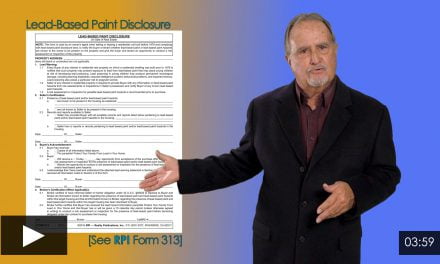Disclosure on material facts
All sellers and their agents to a prospective buyer have the general duty to disclose all known conditions about a property that may adversely affect the desirability or value of the property. Collectively, these are called material facts. [Calif. Civil Code §1102]
Material facts include information about:
- the physical aspects and condition of improvements on the property;
- natural hazards affecting the location of the property;
- environmental hazards on or near the property;
- financial aspects (i.e., the property’s income, expenses and mortgages);
- property title covenants, conditions and restrictions (CC&Rs) regarding use;
- the area surrounding the property’s location; and
- the suitability and zoning of the property for the intended purposes expressed by the buyer.
A seller of a one-to-four unit residential property completes and delivers to a prospective buyer a statutory form called a Transfer Disclosure Statement (TDS), more generically called a Condition of Property Disclosure Statement. [See RPI Form 304]
The seller uses the TDS to set forth any property defects known or suspected to exist which may negatively affect the value or desirability of the property. Disclosures to the buyer are not limited to the general items preprinted on the form. [CC §1102.8]
However, most sellers and their agents, when preparing disclosures, willingly neglect to provide information about recent criminal activity within the neighborhood — whether known or suspected by either. [See RPI Form 321]
As an agency rule, when a seller employs an agent to sell their property, both the agent, the licensee marketing the property, and the seller, as the owner of the property, owe a general duty to prospective buyers to disclose all known facts affecting the value, use and desirability of the property — and the surrounding area. [See RPI e-book Real Estate Principles, Chapter 13]
Related Video: TDS: Mandated on One-to-Four Residential Units
Click here for more information on the TDS form.
Neighborhood nuisances
Although the TDS is not specific to surrounding neighborhood security or local criminal activity and might not name all factors which might affect a property, the TDS broadly calls for the seller to provide information regarding neighborhood nuisances.
Neighborhood and area conditions which adversely affect the property’s value and desirability are material facts compelling disclosure to prospective buyers seeking further information about a property they may acquire. [See RPI Form 308]
Disclosure of facts yielding a negative effect on the value of property is required regardless of whether the negative effect is expressed as an item on a pre-printed TDS form or questioned by the buyer. Anything less is deceit, and thus a fraud on the buyer by the seller’s broker and agent.
Thus, a seller’s agent discloses the existence of unique external factors or conditions affecting a property’s desirability or security conditions surrounding the property when preparing a marketing package for the sale, exchange, lease or option of a one-to-four unit residential property or on demand from a prospective buyer or their agent. [See RPI Form 308 and 321]
Related article:
Brokerage Reminder: Neighborhood Security – Is it safe out there?
Unique factors and conditions
A seller’s agent uses the Unique Factors and Conditions Affecting Property form published by Realty Publications, Inc. (RPI) when preparing a marketing package for the sale, exchange, lease or option of a one-to-four unit residential property. The form allows the agent to disclose the existence of unique factors or conditions which may adversely affect the property or its immediate vicinity. [See RPI Form 308]
The Unique Factors and Conditions Affecting Property form lists several factors which may influence a buyer’s decision to purchase or the price they are willing to pay for a particular property. These factors and conditions include:
- Notice of Airport in Vicinity: The property is located in an airport influence area which may subject occupants to annoyances or inconveniences such as noise, vibration or odors [See RPI Form 308 §2];
- Notice of Right to Farm: The property is located within one mile of a farm or ranch land and may be subject to inconveniences or discomforts resulting from agricultural operations [See RPI Form 308 §3];
- Notice of San Francisco Bay Conservation and Development Commission Jurisdiction: The use and development of property within this commission’s jurisdiction may be subject to special regulations, restrictions and permit requirements [See RPI Form 308 §4];
- Notice of Mining Operations: The property is located within one mile of a mine operation and may be subject to mining-related inconveniences [See RPI Form 308 §5];
- Notice of Industrial Use Zone: The property is located in or next to an Industrial Use Zone which allows manufacturing or commercial uses [See RPI Form 308 §6];
- Notice of State or Federal Ordinance: The property is located within one mile of a former state or federal ordinance location, such as those used for military training purposes [See RPI Form 308 §7];
- Notice of Contamination of a Controlled Substance: A government health official has identified the property or immediate vicinity as being contaminated by methamphetamine or another controlled substance in the prior three years [See RPI Form 308 §8];
- Notice of Death: A death has occurred on the property within the prior three years [See RPI Form 308 §9];
- Notice of Insurance Claim Affecting the Property: An insurance claim affecting the property has been filed within the previous five years, and may increase the cost of insuring the property for subsequent owners [See RPI Form 308 §10]; and
- Notice of Other Conditions affecting the property or immediate vicinity for the agent to list. [See RPI Form 308 §11]
A blank space is provided at the bottom of the form for the agent to explain any of the checked items in further detail. [See RPI Form 308 §12]
After review and consideration of these seller disclosures, the buyer is able to make an informed decision whether to proceed with the purchase, negotiate an adjustment in the price to cover the value of the disclosed risks, or cancel and find a property with fewer associated risks and costs.
Related article:
Neighborhood security
A seller’s agent uses the Seller’s Neighborhood Security Disclosure published by RPI when preparing a marketing package which includes information addressing security on or about a property they have listed for sale or lease, or on demand from a prospective buyer/tenant or their agent. The addendum allows the agent to prepare a disclosure for delivery to prospective buyers of facts known or readily available about security conditions on or in the area of the property. [See RPI Form 321]
Each section of the Seller’s Neighborhood Security Disclosure has a separate principle relating to the security of the occupants of the property. The sections include:
- a statement from the seller disclosing any investigative reports on the adequacy of the property’s security arrangements [See RPI Form 321 §2];
- security precautions already undertaken, including steps taken by the seller or prior owner to prevent security breaches [See RPI Form 321 §3];
- conduct on the property by a tenant, their pets or visitors which have endangered another person or the property of another [See RPI Form 321 §4]; and
- any other specific criminal activities occurring on the property during the past two years, including theft, vandalism, trespass or assault. [See RPI Form 321 §5]
Although the disclosure of security conditions which exist on and around a property is not statutorily mandated, timely disclosure provides material information to the buyer under case law when the information is “readily available” and “relevant to a buyer’s decision.” Thus, the seller’s disclosure is not just good practice — it’s a legally critical supplement to the statutory TDS and part of a thorough marketing package.
Related article:
Want to learn more about disclosing material facts? Click the image below to download the RPI book cited in this article.

















